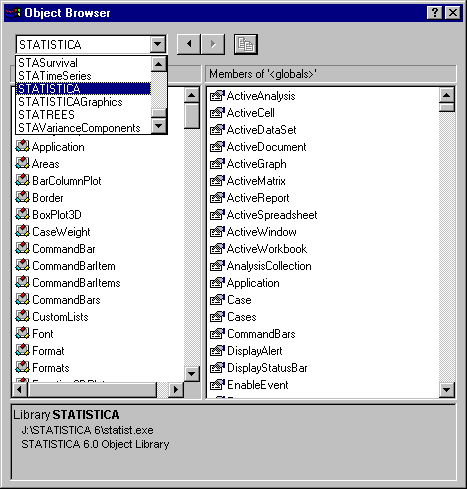Statistica Libraries and Modules
All statistical procedures and graphs and their customization are available as properties or functions to Statistica Visual Basic (SVB).
In order to provide a transparent programming environment for the user, the analysis objects and properties belonging to those objects are arranged to correspond to the respective flow of options and dialog boxes, as if the respective analyses were performed interactively. In addition, a large number of properties, functions, constants, and events (subroutines associated with particular user-initiated events performed in documents; e.g., right-clicking on a results spreadsheet) are available to manage documents, files, and various general analysis options. To review the libraries and scope of the installation of SVB on your computer, display the Object Browser: Create a new macro (select New from the File menu; on the Create New Document dialog box, select the Macro (SVB) Program tab, and create a macro), and then select Object Browser from the View menu.
Following is a list of the currently available Statistica modules and the name of the respective libraries accessible to Visual Basic:
| Module (Option) | Library Name | Symbolic Constant |
| ANOVA* | STAMANOVA | scMANOVA |
| Association Rules | STAASC | scAssociation |
| Basic Statistics | STABasicStatistics | scBasicStatistics |
| Boosted Trees | STABTrees | scBoostingTrees |
| Canonical Analysis | STACanonical | scCanonicalAnalysis |
| Classification Trees | STAQuickTrees | scQuickTrees |
| Cluster Analysis | STACluster | scClusterAnalysis |
| Correspondence Analysis | STACorrespondence | scCorrespondenceAnalysis |
| Discriminant Analysis | STADiscriminant | scDiscriminantAnalysis |
| Distribution Fitting† | STANonparametrics | scDistributions |
| Drill-Down Explorer | STADrillDown | scDrillDown |
| Experimental Design (DOE) | STAExperimental | scDesignOfExperiments |
| Factor Analysis | STAFactor | scFactorAnalysis |
| Feature Selection | STAFSL | scFeatureSelection |
| General CHAID Models | STAGCHAID | scGCHAID |
| General Classification
and Regression Trees |
STAGTrees | scGTrees |
| General Discriminant Analysis Models | STAGDA | scGDA |
| Generalized Additive Models | STAGAM | scGAM |
| Generalized Clustering | STAGCluster | scGeneralClusterAnalysis |
| Generalized Linear/Nonlinear Models | STAGLZ | scGLZ |
| General Linear Models | STAGLM | scGLM |
| General Partial Least Squares Models | STAPLS | scPLS |
| General Regression Models | STAGRM | scGRM |
| Goodness of Fit | STAGoodnessOfFit | scGoodnessOfFit |
| Interactive Trees | STAITrees | scInteractiveTrees |
| Log-Linear Analysis | STALogLinear | scLogLinearAnalysis |
| Machine Learning Methods | STAMachineLearning | scMachineLearning |
| MARSplines | STAMARSplines | scMARSplines |
| Multidimensional Scaling | STAMultidimensional | scMultidimensionalScaling |
| Multiple Regression | STARegression | scMultipleRegression |
| Neural Networks | STANeuralNetworks | scNeuralNetworks |
| Nonlinear Estimation | STANonlinear | scNonlinearEstimation |
| Nonparametrics | STANonparametrics | scNonparametrics |
| Principal Components and Classification Analysis‡ | STAFactor | scAdvancedPCA |
| Process Analysis Techniques | STAProcessAnalysis | scProcessAnalysis |
| Quality Control | STAQuality | scQualityControl |
| Rapid Deployment of Models | STARapidDeployment | scRapidDeploy |
| Reliability/Item Analysis | STAReliability | scReliabilityAndItemAnalysis |
| Survival Analysis | STASurvival | scSurvivalAnalysis |
| Text Miner | STATextMiner | scTextMining |
| Time Series | STATimeSeries | scTimeSeries |
| Variance Components | STAVarianceComponents | scVarianceComponents |
*The ANOVA Results dialog box functions are accessible via the General Linear Models library.
†The Distribution Fitting module functions and routines are part of the Nonparametrics library.
‡The Principal Components and Classification Analysis techniques are accessible via the Factor Analysis library.
Note 1: The list of modules and procedures and Statistica libraries available to Visual Basic is constantly growing.
Note 2: The Graphs menu graphs are all part of the Statistica main reference library; you can review the respective constants to instantiate a particular analysis (graph type) in the Object Browser.

